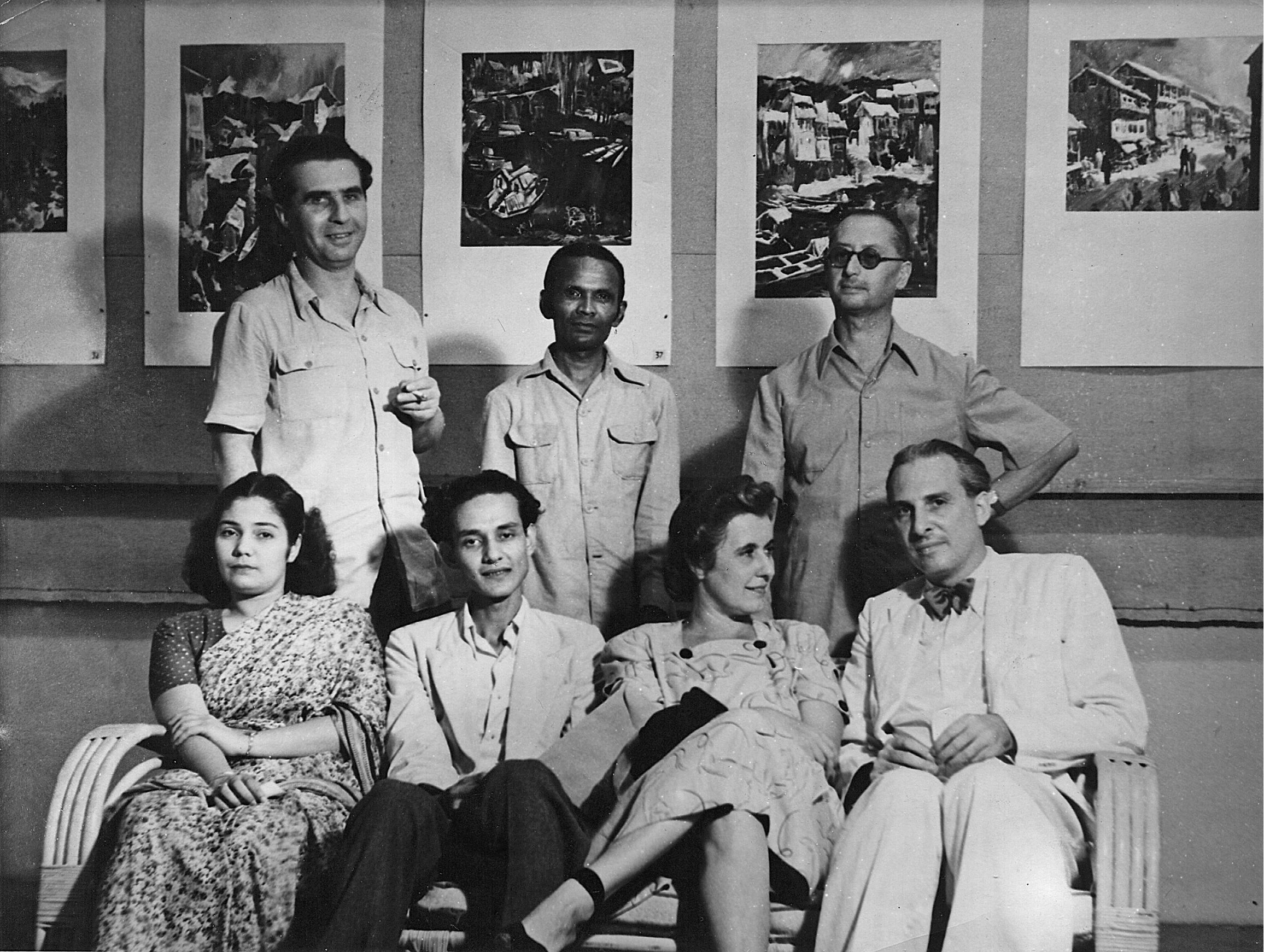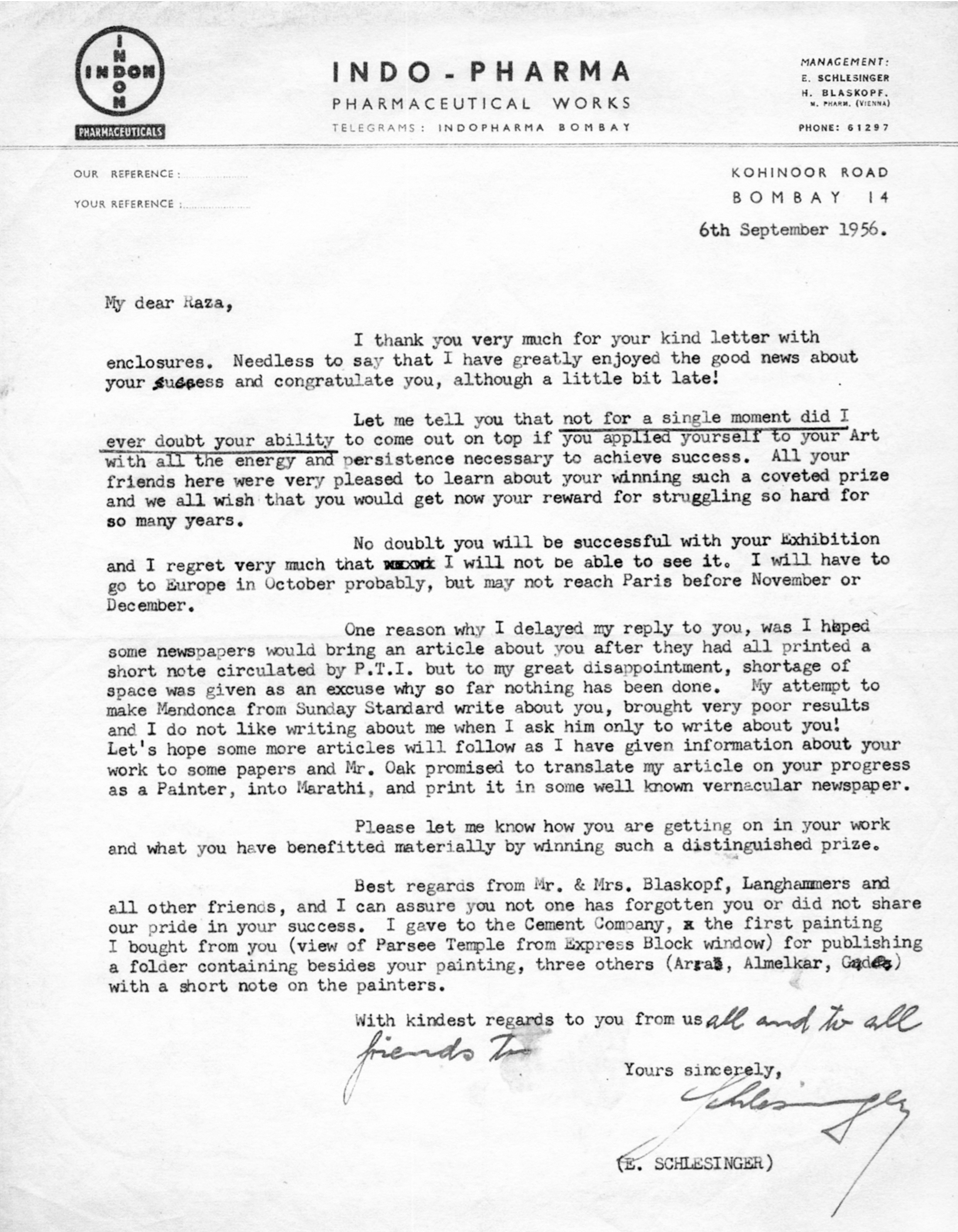Archive
Emanuel Schlesinger
- Emanuel
- Schlesinger
- 04-01-1896
- Zemun (RS)
- 01-11-1968
- Mumbai (IN)
- Factory OwnerTechnical DirectorArt CollectorArt Critic
The art collector Schlesinger provided primarily financial aid by creating working opportunities for young artists in post-independence Bombay, and initiated the corporate culture of buying art.
Word Count: 26

Opening of the Raza exhibition, first row from left: Unknown, S.H. Raza, Käthe Langhammer, Rudolf von Leyden, second row from left: Walter Langhammer, K.H. Ara, Emanuel Schlesinger, 1948 (Digital Photo Archive Margit Franz, authorized by the late S.H. Raza © Raza archive; All Rights Reserved). 
Letter from Emanuel Schlesinger (Bombay) to S. H. Raza (Paris), September 1956, on official INDON letterhead paper (Reprinted from: Vajpeyi 2013, 96; Image courtesy: The Raza Foundation). 
Emanuel Schlesinger (far left, seated in the first row) at the opening of the Chemould Gallery at Jehangir Art Gallery Main Hall, September 1963 (Digital Photo Archive Margit Franz © Gandhy Archive, Mumbai; All Rights Reserved). 
Early Raza painting Street Scene in Bombay from Schlesinger Collection as a calendar print (Photo: Margit Franz 2010; All Rights Reserved). Dalmia, Yashodhara. The Making of Modern Indian Art: The Progressives. Oxford University Press, 2001.
Dhage, Vrushali. “P. A. G. and the Role of the Critics.” art etc. news & views, February 2012, www.artnewsnviews.com/view-article.php?article=p-a-g-and-the-role-of-the-critics&iid=30&articleid=848. Accessed 18 April 2021.
Franz, Margit. “Transnationale & transkulturelle Ansätze in der Exilforschung am Beispiel der Erforschung einer kunstpolitischen Biographie von Walter Langhammer.” Mapping Contemporary History. Zeitgeschichten im Diskurs, edited by Margit Franz et al., Böhlau, 2008, pp. 243–272. Academia, www.academia.edu/45523873/Transnationale_und_transkulturelle_Ans%C3%A4tze_in_der_Exilforschung_am_Beispiel_der_Erforschung_einer_kunstpolitischen_Biographie_von_Walter_Langhammer. Accessed 14 March 2021.
Franz, Margit. “Graz – Wien – Bombay – London: Walter Langhammer, Künstler und Kunstförderer.” Historisches Jahrbuch der Stadt Graz, vol. 40, edited by F. Bouvier, and N. Reisinger, Stadt Graz – Kulturamt, 2010, pp. 253–276. Academia, www.academia.edu/45524011/Graz_Wien_Bombay_London_Walter_Langhammer_Künstler_und_Kunstförderer. Accessed 14 March 2021.
Franz, Margit. Gateway India: Deutschsprachiges Exil in Indien zwischen britischer Kolonialherrschaft, Maharadschas und Gandhi. CLIO, 2015.
Franz, Margit. “From Dinner Parties to Galleries: The Langhammer-Leyden-Schlesinger Circle in Bombay – 1940s through the 1950s.” Arrival Cities. Migrating Artists and New Metropolitan Topographies in the 20th Century, edited by Burcu Dogramaci et al., Leuven University Press, 2020, pp. 73–90. Project Muse, doi: 10.1353/book.77990. Accessed 30 March 2021.
Franz, Margit. “Die multiplen Identitäten und Loyalitäten der Käthe Langhammer.” Das Exil von Frauen. Historische Perspektive und Gegenwart (biografiA. Neue Ergebnisse der Frauenbiografieforschung, 26), edited by Ilse Korotin and Ursula Stern, Praesens Verlag, 2020, pp. 148–167.
Rushdie, Salman. The Moor’s Last Sigh. Random House, 1997.Rushdie, Salman. Midnight’s Children. Cape, 1981.
Schürer, Norbert. Salman Rushdie’s Midnight’s Children: A Reader’s Guide. Continuum, 2004.
Vajpeyi, Ashok, and Shruthi Issac, editors. Geysers: Letters Between Raza & Akbar Padamsee, Bal Chhabda, E. Schlesinger, F.N. Souza, Laxman Pai, M.F. Husain, R.V. Leyden, S.K. Bakre, Tyeb Mehta, V.S. Gaitonde, Ram Kumar, Walter Longhammar (Raza correspondence, vol. 2). Vadehra Art Gallery, n.d. [2013].
Zitzewitz, Karin. The Perfect Frame: Presenting Modern Indian Art. Stories and Photographs from the Collection of Kekoo Gandhy. Chemould Publications and Arts, 2003.
Word Count: 345
Private Archive Margit Franz, Sinabelkirchen.
Archival records from personal interviews between the author and Khorshed and Kekoo Gandhy, Mumbai, 30 April to 3 May 2003; 18 to 22 January 2004; 26 April to 12 May 2007; 13 to 15 October 2008; 24 October 2010.
Archival records from personal interviews between the author and S.H. Raza, Paris, 3 to 4 July 2006; and Gorbio, 18 August 2010.
Archival records from a personal interview between Yashodhara Dalmia and Maseeh Rahman and Käthe Langhammer, London, August 1993 (Private Archive Margit Franz: digital audio material and transcription).
Private Archive of late Khorshed & Kekoo Gandhy Archive, Mumbai
Private Archive James von Leyden, Lewes
National Archive of India, New Delhi, Application from Mr Emanuel Schlesinger to Austrian Jewish Refugee For Naturalisation Under the British Nationality and Status of Aliens Act 1914 (National Archives of India, New Delhi), Home Political/E/1946/ F32–27.Bombay Art Society exhibition catalogues from 1938 till 1960.
Times of India Archive via Staatsbibliothek zu Berlin:
http://erf.sbb.spk-berlin.de/historical-newspapers/. Accessed 18 April 2021.Word Count: 148
Bombay, India (1939–1968).
Indo Pharma Pharmaceutical Works Private Ltd., Shanti Bhavan, 83 Kohinoor Road, Dadar, Bombay 14 (now 83, Swami Gyan Jivandas Marg, Lokmanya Tilak Colony, Dadar, Mumbai) (residence and work, 1939–1946); Windsor Villa, Westfield Park, Warden Road, Bombay 26 (now Windsor Villa, 1 Westfield Estate, Bhulabhai Desai Road, Cumballa Hill) (residence, 1946).
- Bombay
- Margit Franz. "Emanuel Schlesinger." METROMOD Archive, 2021, https://archive.metromod.net/viewer.p/69/2951/object/5138-11881499, last modified: 31-07-2021.
-
Mulk Raj AnandWriterPhilosopherArt PatronCultural CriticBombay
As a global socialist and modernist, Mulk Raj Anand sought and shaped opportunities for intellectual exchanges between Asia and Europe.
Word Count: 20
Rudolf von LeydenGeologistAdvertisement SpecialistJournalistArt CriticArt CollectorCartoonistBombayThe advertisement expert, Rudolf von Leyden, became a major art critic and art historian in Bombay in the 1940s, advocating an urgent need for modernism in art in post-colonial India.
Word Count: 30
Iconic Photo of the Progressive Artists’ Group and Their AssociatesPhotographBombayThere are two versions of the PAG photo at the opening of M.F. Husain's first solo exhibition in 1950 (published in 1996 and 2003) and two narratives about the opening.
Word Count: 28
Picture of Rudi von Leyden’ s Bust by Sadanand K. BakrePhotographBombayThe picture of the previously lost and recently located sculpture by Sadanand K. Bakre reflects the relationship between the artist Bakre and the art critic Rudi von Leyden.
Word Count: 28
Baumgartner’s BombayBookBombayThe novel Baumgartner’s Bombay provides an opposite picture to that of the successful refugee in Bombay. Anita Desai’s fiction depicts poverty and failure in Indian exile.
Word Count: 28
One Man exhibition and subsequent trial, Akbar PadamseeCourt CaseBombayAkbar Padamsee’s solo exhibition in Bombay in 1954 was overshadowed by his arrest on charge of displaying obscene pictures. The subsequent court case drew support from across the art world.
Word Count: 30
Open Studio Evenings by Käthe and Walter LanghammerSalonBombayThe painter Walter Langhammer and his wife Käthe built an informal infrastructure to promote local avant-garde artists and regularly invited them to Open Studio Evenings at their studio.
Word Count: 29
Institute of Foreign LanguagesLanguage SchoolExhibition SpaceLibraryTheatreBombayWith its wide range of cultural activities, the Institute of Foreign Languages − founded in 1946 by the Viennese emigrant Charles Petras − became a glocal contact zone in Bombay.
Word Count: 27
Bombay Art SocietyAssociationBombayOne of the oldest art societies in India founded by colonial rulers, Bombay Art Society showcased art students and professional artists from all over India, including the Progressive Artists of Bombay.
Word Count: 31
Kekoo Minochair GandhyFrame Shop OwnerGalleristArt CollectorBombayStarting from a cosmopolitan milieu for young local artists, Kekoo and his wife Khorshed Gandhy developed a business model that turned the frame shop into Gallery Chemould.
Word Count: 27
The Leydens: Sculpture, Paintings, CartoonsExhibitionBombayIn 1948 Albrecht and Rudi von Leyden sold their personal works of art in order to set up an “Artists' Aid Fund”, which became an institution in the following years.
Word Count: 29
Schimmel’s Wedding Film 1948FilmBombayThe film shows Schimmel’s Jewish wedding ceremony at the prestigious Glamis Villa, followed by lunch at the Taj Mahal Hotel. Among the guests were Käthe and Walter Langhammer.
Word Count: 30
Jewish Relief Association BombayRelief OrganisationBombayIn 1934, the first refugees from National Socialism founded a Jewish aid association in Bombay called the Jewish Relief Association (JRA) to help refugees in financial and other difficulties.
Word Count: 28